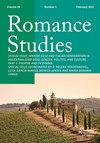Cold War Chronology in Vargas Llosa’s Travesuras de la niña mala
IF 0.2
3区 文学
0 LITERATURE, ROMANCE
引用次数: 0
Abstract
ABSTRACT This romantic novel has been studied primarily in terms of the portrait of its female protagonist. Unmentioned by prior scholarly studies is the fact that throughout the novel, Vargas Llosa discreetly yet consistently dates plot developments, allowing the reader to deduce that the female protagonist dies in July 1989, the date of the author’s final experience of Europe during the Cold War. Drawing on this structure, the present article argues that the post-1989 historical events and social trends that appear in the text are not authorial chronological errors, but rather represent a deliberate effort on Vargas Llosa’s part to subsume the post-1989 world into the ethos of the Cold War years, when, as he argues in La civilización del espectáculo (2012), an essay collection written in part concurrently with Travesuras de la niña mala, books and ideas mattered more than is the case in the 1990s or the twenty-first century. In order to achieve this absorption of the post-Cold-War world by the pre-1989 period, this article maintains, Vargas Llosa depoliticizes the Cold War years, portraying them not in terms of East-West ideological struggle, but rather as an era of the flourishing of literary culture centred in Paris.巴尔加斯·略萨的《坏女孩的恶作剧》中的冷战年表
对这部言情小说的研究主要从小说女主角的形象入手。之前的学术研究没有提到的是,在整部小说中,巴尔加斯·略萨谨慎而一贯地确定了情节发展的日期,让读者推断出女主人公死于1989年7月,这是作者在冷战期间最后一次经历欧洲的日子。利用这一结构,本文认为,文本中出现的1989年后的历史事件和社会趋势并不是作者的时间顺序错误,而是巴尔加斯·略萨(Vargas Llosa)有意将1989年后的世界纳入冷战时期的精神,当时,正如他在《civilización del espectáculo》(2012)中所指出的那样,一部与《niña马拉游记》(travelesuras de La mala)同时撰写的随笔集,与20世纪90年代或21世纪相比,书籍和思想更重要。为了实现1989年之前对冷战后世界的吸收,本文认为,巴尔加斯·略萨将冷战时期去政治化,不是从东西方意识形态斗争的角度来描绘它们,而是把它们描绘成一个以巴黎为中心的文学文化繁荣的时代。
本文章由计算机程序翻译,如有差异,请以英文原文为准。
求助全文
约1分钟内获得全文
求助全文

 求助内容:
求助内容: 应助结果提醒方式:
应助结果提醒方式:


